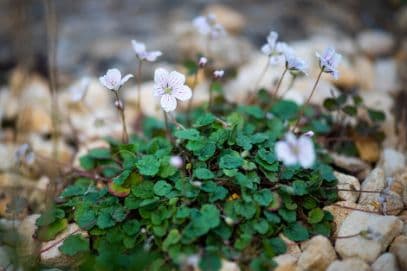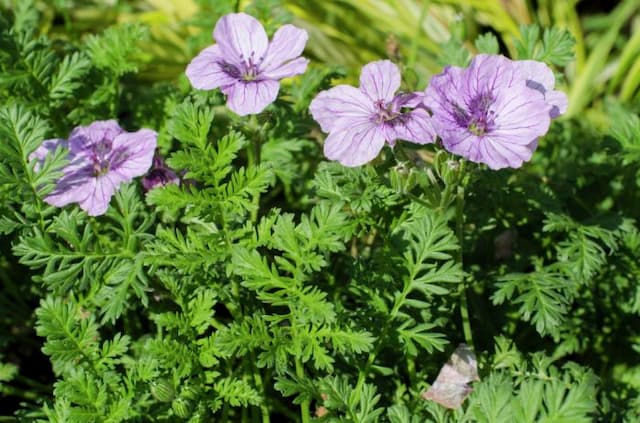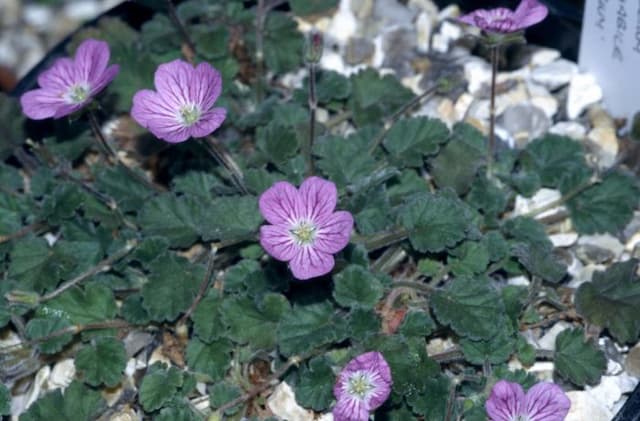Geranium Pelargonium 'Darmsden' (A)

ABOUT
Pelargonium 'Darmsden' (A), commonly known as geranium, is a showy plant admired for its ornamental qualities. The looks of this geranium are characterized by vibrant flowers and decorative foliage. The flowers typically come in clusters, known as umbels, and display an array of magnificent hues that might include shades of pink, red, purple, or white. Each flower consists of five petals that could be veined or marked, adding further intricacy to their appearance. The leaves of the geranium are equally appealing, often green in color and bearing a unique patterning and fuzzy texture. They are generally rounded with lobed margins, and can give off a pleasant aroma when brushed or crushed. Some varieties may feature leaves that are edged with a contrasting color, such as a reddish hue, which adds to the visual interest of the plant. Together, the vibrant blooms and the attractive foliage make Pelargonium 'Darmsden' a popular choice for gardeners wanting to add a splash of color to their outdoor (or even indoor) spaces. The geranium's overall aesthetic makes it a versatile plant for decorative pots, hanging baskets, or as a bedding plant in gardens, where its appearance is sure to stand out and capture the attention of onlookers.
About this plant
 Names
NamesFamily
Geraniaceae
Synonyms
Darmstadt Pelargonium, Darmsden Geranium
Common names
Pelargonium 'Darmsden'.
 Toxicity
ToxicityTo humans
The Pelargonium 'Darmsden' is commonly known as a geranium. Generally, geraniums are not considered highly toxic to humans. However, if ingested in large quantities, they could potentially cause minor symptoms like nausea, vomiting, or diarrhea. Most individuals will not experience severe effects from eating parts of a geranium, but sensitive individuals may have a more pronounced reaction. It's always advisable to avoid ingesting ornamental plants as a precaution.
To pets
Geraniums, including the Pelargonium 'Darmsden', can be toxic to pets if ingested. The most common symptoms of poisoning in pets, particularly in dogs and cats, can include vomiting, anorexia, depression, and dermatitis. In severe cases, ingestion can potentially lead to more serious effects such as hypothermia or even respiratory failure. It is important to keep geraniums out of reach of pets and to seek veterinary attention if you suspect your pet has ingested part of the plant.
 Characteristics
CharacteristicsLife cycle
Perennials
Foliage type
Evergreen
Color of leaves
Green
Flower color
Varies
Height
1-2 feet (30-60 cm)
Spread
1-2 feet (30-60 cm)
Plant type
Herb
Hardiness zones
10
Native area
South Africa
Benefits
 General Benefits
General Benefits- Aesthetic Appeal: The plant has vibrant and colorful flowers that can enhance the visual appeal of gardens and indoor spaces.
- Low Maintenance: Pelargoniums are known for being easy to care for, requiring minimal watering and care.
- Drought Tolerance: They can survive with less water, making them ideal for dry climates or water-wise gardening.
- Attracts Pollinators: The flowers can attract beneficial insects such as bees and butterflies to your garden.
- Versatility: These plants can be grown in pots, hanging baskets, or directly in the ground, suitable for various landscaping approaches.
- Long Blooming Period: Pelargoniums often have a lengthy blooming time, providing color for extended periods.
- Fragrance: Some varieties emit a pleasant scent which can contribute to a fragrant garden or indoor environment.
- Easy Propagation: They can be easily propagated from cuttings, allowing gardeners to produce more plants economically.
 Medical Properties
Medical Properties- This plant is not used for medical purposes.
 Air-purifying Qualities
Air-purifying QualitiesThis plant is not specifically known for air purifying qualities.
 Other Uses
Other Uses- Potpourris and Scented Items: The leaves of the pelargonium can be dried and added to potpourris or used to infuse sachets, providing a pleasant fragrance for drawers and closets.
- Insect Repellent: The essential oils in pelargonium can be used to create natural insect repellents, particularly for mosquitoes and gnats.
- Culinary Flavors: The edible petals of some pelargonium varieties can be used to flavor sugar, desserts, or beverages with a subtle floral note.
- Companion Planting: Pelargonium plants can be used in gardens to help deter pests from other plants due to their strong scent.
- Bath Additives: The leaves and flowers, when added to bathwater, can create a fragrant and relaxing bathing experience.
- Natural Dyes: The flowers of pelargonium may be used in the production of natural dyes for fabrics or paper.
- Art and Crafts: Dried pelargonium flowers can be incorporated into various crafts such as candle making, or pressed flower art.
- Decorative Ice Cubes: Small pelargonium flowers can be frozen into ice cubes to add an attractive touch to cold beverages.
- Floral Arrangements: Fresh or dried pelargonium flowers and foliage can be used in floral arrangements and bouquets for a touch of color and texture.
- Garden Stepping Stones: Pelargonium leaves can be used as decorative imprints in making concrete garden stepping stones.
Interesting Facts
 Feng Shui
Feng ShuiThe plant Pelargonium, commonly known as Geranium, is not specifically used in Feng Shui practice.
 Zodiac Sign Compitability
Zodiac Sign CompitabilityThe Geranium is not used in astrology practice.
 Plant Symbolism
Plant Symbolism- Comfort: Due to their homely and pleasant scent, Pelargoniums, commonly known as geraniums, are often associated with comfort and the embracing of familiar, cozy surroundings.
- Friendship: Giving someone a geranium can signify a desire for deeper friendship or can be a way to express gratitude for a friend's support.
- Harmony: Geraniums are believed to foster harmony and peaceful energy, often used in gardens and homes to create a tranquil atmosphere.
- Healing: The geranium's colorful flowers and soothing fragrance are thought to have healing properties, symbolizing a wish for someone's quick recovery or good health.
- Protection: In folklore, the geranium is sometimes used as a protective charm, to ward off negative influences and evil spirits.
 Water
WaterGeraniums, commonly known as Pelargoniums, prefer even moisture; however, they are drought tolerant and do not like to sit in waterlogged soil. It's best to water these plants deeply once the soil feels dry to the touch, about once a week. To water a Geranium, thoroughly soak the soil with approximately 16 ounces (1 pint) of water per plant, ensuring the water penetrates the root zone. During hot, dry periods, you may need to water every 3 to 4 days, while in cooler, humid conditions, watering frequency may decrease to once every 10 to 14 days. Overwatering can lead to root rot, so it's crucial to allow the soil to dry out between waterings.
 Light
LightGeraniums thrive in bright, indirect light and can benefit from some direct sunlight, but harsh afternoon sun might be too intense. The ideal spot for a Geranium would be in an east- or west-facing window where it receives moderate light with some direct morning or late afternoon sun. Avoid placing them in full shade or overly dark rooms, as insufficient light can lead to poor flowering and leggy growth.
 Temperature
TemperatureGeraniums prefer a temperate range of 65 to 75 degrees Fahrenheit during the day and should not be exposed to temperatures below 50 degrees at night. They can survive brief periods down to 32 degrees but it's not ideal for the plant's health. To encourage robust growth and flowering, keeping the Geranium in its preferred temperature range is essential; avoid exposure to drafts and extreme temperature fluctuations.
 Pruning
PruningPruning Geraniums encourages bushier growth and prevents them from becoming leggy. It's best to prune these plants in the spring or early summer, removing dead or yellowed leaves and spent flowers regularly to promote new growth and blooms. Pinching back the growing tips can also help create a fuller plant. Prune about once a month during the growing season, or as needed, to maintain the desired shape and size.
 Cleaning
CleaningAs needed
 Soil
SoilGeranium 'Darmsden' thrives in a well-draining soil mix comprising two parts peat moss, one part perlite, and one part potting soil. Ensure a soil pH between 6.0 and 7.0 for optimal growth.
 Repotting
RepottingGeranium 'Darmsden' should be repotted every two to three years, or when it outgrows its current pot, to ensure continued growth and health.
 Humidity & Misting
Humidity & MistingGeranium 'Darmsden' prefers moderate humidity levels, generally around 40-60%, and can tolerate indoor conditions without needing extra humidity.
 Suitable locations
Suitable locationsIndoor
Place in bright, indirect light and keep soil moderately dry.
Outdoor
Full sun to partial shade, protect from frost and extreme heat.
Hardiness zone
9-12 USDA
 Life cycle
Life cyclePelargonium 'Darmsden', commonly known as a type of Geranium, begins its life cycle as a seed, germinating in warm, moist soil in spring when temperatures are suitable. Upon sprouting, it enters the vegetative stage, forming a rosette of leaves and then developing a sturdy stem and a bushy structure with more leaves. As it matures, it enters the flowering stage, producing clusters of colorful and often fragrant flowers, and this stage can last from spring until fall with proper care. Following pollination, which can be facilitated by insects or wind, the plant produces fruits that contain seeds, ensuring the continuation of its species. Once the seeds are dispersed, the plant may enter a period of dormancy over the winter, particularly in cooler climates, although Pelargoniums are often treated as annuals and may not survive freezing temperatures. The cycle restarts with the next generation if seeds successfully overwinter and germinate when the conditions become favorable again.
 Propogation
PropogationPropogation time
Spring-summer
The Pelargonium 'Darmsden', commonly known as a geranium, can be propagated most successfully through stem cuttings. This method is best performed in late summer, but it can also be accomplished successfully in spring. To propagate by cuttings, select a healthy stem that is about 4 to 6 inches (10 to 15 cm) long and has at least two sets of leaves. Using a sharp, clean knife or scissors, make a cut just below a leaf node. Remove the bottom leaves and dip the cut end into a rooting hormone to encourage root growth. Plant the cutting in a pot filled with a well-draining soil mix and keep it moist but not waterlogged. Place the pot in a warm spot with bright, indirect light until the cutting has rooted, which typically takes about 4 to 8 weeks.




![Cranesbill [Blue Sunrise]](/_next/image?url=https%3A%2F%2Fplants-admin.emdemapps.com%2Fimages%2Fplants%2F%2Fimages%2F604b638d45948.png&w=640&q=75)




